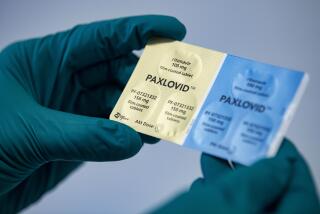Science / Medicine : ON MEDICINE : Information Lapse Slows Word on AIDS Treatments
- Share via
The National Institute of Allergy and Infectious Diseases, which sponsors a substantial proportion of U.S. AIDS research, has an annual budget of more than $900 million, including about $950,000 for its communications office.
But not one cent is specifically allocated to inform physicians about treatment advances against AIDS or other deadly diseases.
This startling fact came to light earlier this month as the federal institute responded to a newspaper story stating that it had delayed publicizing its recommendations for the use of a potentially life-saving treatment advance against a common AIDS-related pneumonia.
The story, which appeared in the New York Times, turned out to be overstated. But it did focus attention on the real problems, including budgets, that plague the NIAID’s efforts to keep physicians informed of state-of-the-art therapies.
“We don’t have funds budgeted for this sort of information dissemination” to physicians, said Elaine Baldwin, chief of information projects in NIAID’s office of communications. “We recognize that we don’t have a good system.”
Baldwin said the institute has “relied on drug companies who have had an interest in getting information out on a particular (AIDS) study” to send letters, at the drug company’s expense, to physicians who are on their mailing lists. Such mailings typically reach only a small percentage of physicians. That method also raises questions about the propriety of the federal government’s reliance on pharmaceutical manufacturers who profit from increased sales of their products.
Ideally, physicians and patients should be fully informed about new treatments for serious illnesses as soon as they are proved effective. While instantaneous access to valid medical information is not realistic, many believe that the federal government could do a far better job in getting the word out.
The new federal recommendations for the treatment of Pneumocystis carinii pneumonia were written by a panel of 17 AIDS experts, including nine from California. After reviewing five clinical trials, the experts called for the use of the steroid drug prednisone in addition to standard antibiotics to treat moderate to severe cases of the pneumonia. Pneumocystis infection is one of the most common causes of death in AIDS patients.
The news that steroids were a promising addition to the standard pneumonia treatment is nothing new. It has been publicized frequently in recent months--for example, in a presentation by a UC San Diego physician at the international AIDS conference in June, which was reported in the Los Angeles Times, and in an article and an editorial in the Annals of Internal Medicine in July.
However, the federal government’s endorsement of the use of steroids has received relatively little attention until this month. Authoritative government recommendations, on diseases ranging from cancer to heart disease to AIDS, can be crucial in encouraging physicians to change the way they practice medicine.
The federal AIDS treatment recommendations were made final in August and discussed at AIDS meetings and on cable television shows aimed at physicians. The report was not made public until last week, when it was published, along with two of the five studies reviewed by the expert panel, in the New England Journal of Medicine.
During the intervening three months, some physicians may have failed to prescribe steroids for AIDS patients who needed them because they were unaware of the expert panel’s conclusions. Baldwin and Dr. Henry Masur, the National Institutes of Health official who chaired the panel, acknowledged in interviews that little was done to directly inform physicians or the public of the recommendations, despite the permission the government received from the New England Journal of Medicine in September to do so.
The NIAID communications office had prepared a three-page “note to physicians” summarizing the “important information on the clinical benefit” of steroids.
On Oct. 10, the summary was sent by LyphoMed/Fujisawa, which manufactures a drug used to treat pneumocystis, to 2,500 physicians on its mailing list. This is fewer than 0.5% of the approximately 600,000 physicians in the United States.
Some newsletters specializing in AIDS treatments also were notified, as was a U.S. Public Health Service toll-free number that provides AIDS information.
NIAID never released its own statement to the public, the news media, hospital intensive care unit directors or leading medical organizations, such as the American Medical Assn., so that they might have notified their members.
In the Public Health Service, “no one takes responsibility for unusual circumstances such as this,” said Dr. Sidney M. Wolfe of the Washington-based Health Research Group, which has repeatedly called for federal health officials to establish a mechanism to swiftly inform physicians of major therapeutic advances in their fields.
“In the future, we may come up with a multi-pronged plan of action,” said Baldwin, of the NIAID. “I think it would be a very good idea.”






